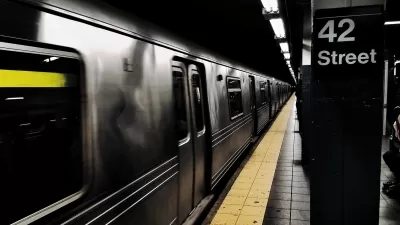It took an effort that was both well-planned and ad-hoc to save NYC's backbone from Hurricane Sandy, and have the city's transit system back up and running again soon after the storm. Robert Sullivan examines that effort and what happens next time.
"The subway is the Mississippi River of personal commerce in New York, for people who work in Midtown, Dumbo, Wall Street. For three days after Sandy hit, it was stopped dead, and for another two days after that, only part of it was running. The closure proved once again that New York does not function without its subway."
"When you look closely at it now, a year later, in the midst of another Atlantic hurricane season, you see all the ways in which the Metropolitan Transportation Authority and New York City Transit failed and triumphed," writes Sullivan. "And you see what it will take to keep the system going: technological improvements, yes, but also the oldest technology of all — the knowledge of the people who run the subway, many of whom have been there for their entire working lives."
"This year, should a Sandy-like storm show up, it won’t encounter a transportation system that has changed conspicuously," he adds. "But the thinking of the people running it has. As one senior official puts it, 'We definitely had tremendous lessons learned.'”
FULL STORY: Could New York City Subways Survive Another Hurricane?

Alabama: Trump Terminates Settlements for Black Communities Harmed By Raw Sewage
Trump deemed the landmark civil rights agreement “illegal DEI and environmental justice policy.”

Planetizen Federal Action Tracker
A weekly monitor of how Trump’s orders and actions are impacting planners and planning in America.

The 120 Year Old Tiny Home Villages That Sheltered San Francisco’s Earthquake Refugees
More than a century ago, San Francisco mobilized to house thousands of residents displaced by the 1906 earthquake. Could their strategy offer a model for the present?

In Both Crashes and Crime, Public Transportation is Far Safer than Driving
Contrary to popular assumptions, public transportation has far lower crash and crime rates than automobile travel. For safer communities, improve and encourage transit travel.

Report: Zoning Reforms Should Complement Nashville’s Ambitious Transit Plan
Without reform, restrictive zoning codes will limit the impact of the city’s planned transit expansion and could exclude some of the residents who depend on transit the most.

Judge Orders Release of Frozen IRA, IIJA Funding
The decision is a victory for environmental groups who charged that freezing funds for critical infrastructure and disaster response programs caused “real and irreparable harm” to communities.
Urban Design for Planners 1: Software Tools
This six-course series explores essential urban design concepts using open source software and equips planners with the tools they need to participate fully in the urban design process.
Planning for Universal Design
Learn the tools for implementing Universal Design in planning regulations.
Clanton & Associates, Inc.
Jessamine County Fiscal Court
Institute for Housing and Urban Development Studies (IHS)
City of Grandview
Harvard GSD Executive Education
Toledo-Lucas County Plan Commissions
Salt Lake City
NYU Wagner Graduate School of Public Service




























